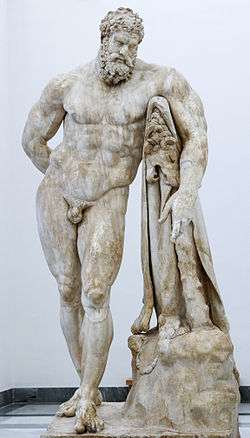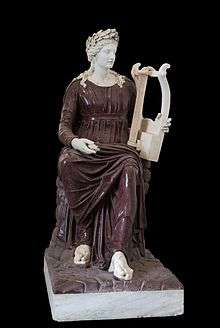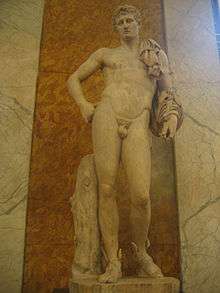Farnese collection

The Farnese Collection is one of the premier collections of artistic items from Greco-Roman Antiquity. It includes some of the most influential classical works, including the sculptures that were part of the Farnese Marbles, their collection of statuary. The works are now displayed in the Naples National Archaeological Museum in Naples and the British Museum in London.[1]
History
The items in the collection were acquired or requisitioned by Cardinal Alessandro Farnese, who became Pope Paul III (1543 - 1549). Classical artworks were routinely uncovered in Roman lands, and during the Renaissance had become much desired. Many were family heirlooms of prominent families in Rome. Alessandro purchased the Sassi and Bernardino Fabio collections, confiscated the Colonna collection, and received the collection of Cardinal Federico Cesi as a donation. Other works were bought in the antiques market, including works that were appearing as part of excavations and construction throughout the city. Michelangelo had designed internal niches to display statuary in the massive Palazzo Farnese (1546) in Rome.
The Farnese collection was further enlarged by the Pope's nephew, another Cardinal Alessandro, by the purchase of the Del Bufalo and Cesarini collections. It also included the inheritance left in 1587 by Margaret of Parma, the widow first of Alessandro de Medici and then of Ottavio Farnese. She also possessed a collection of famous engraved gems, which formerly belonged to Lorenzo dei Medici, including the Farnese Cup, and important marble sculptures such as the Pergamene statues.
The Farnese’s trusted collector and antiquarian Fulvio Orsini aided in shopping for other works and on his death, left his collection of gems, coins and busts to Odoardo Farnese. Among the works were two statues of Hercules, two statues of “Flora” and the two Gladiators were placed beneath the arches of the courtyard of the Palazzo; while the Farnese Bull was placed in a special enclosure in the second courtyard.
Display
Inside ancient statues were arranged according to themes within the Farnese Palace. In the Gran Salone, the Sala degli Imperatori, the Sala dei Filosofi and the Galleria dei Carracci were valuable marbles. The Annibale Carracci ceiling frescoes depicting the The Loves of the Gods were painted not only to celebrate a wedding, but also commented on statuary in the niches below the frescoes.
Move to Naples
The Farnese family, who had become Dukes of Parma declined till the death of Antonio Farnese of Parma, and thus the collection passed through Elisabetta Farnese, wife of Philip V of Spain, to their son Charles of Bourbon, who became king of Naples and the Two Sicilies in 1734. He in turn decided to move the Parmesan collections to Naples. His son Ferdinand IV of Naples brought the Roman collections to Naples. This occurred in 1787, despite the strong opposition of the Papacy. Many of the marble sculptures were restored by Carlo Albacini (1735-1813). The Farnese collections are still exhibited together, although arranged by themes. Some have been moved to the Capodimonte Museum. Residual sculptures from the Farnese collection were acquired by the British Museum in 1864. Numbering 10 items in total, they are currently displayed in galleries throughout the museum, including the Enlightenment Gallery and the Great Court.
Famous items form the Farnese collection
The collection contains many copies of ancient Greek originals, and provides a broad review of classic Roman sculpture. Among the prizes of the collection are:
- Farnese Cup
- Farnese Bull, Farnese Hercules, Farnese Flora, Lars, Athena, and Farnese Gladiator came from the Baths of Caracalla
- Venus Kallipygos (Callipige Aphrodite)
- Pan and Daphnis
- Farnese Atlas
- Farnese Minerva (from Velletri)
- Farnese Homer
- Farnese Bacchus
- Farnese Diadumenos (British Museum)
- Farneses Hermes (British Museum)
- Farnese Captives
See also
References
External links
| Wikimedia Commons has media related to Farnese Collection. |

